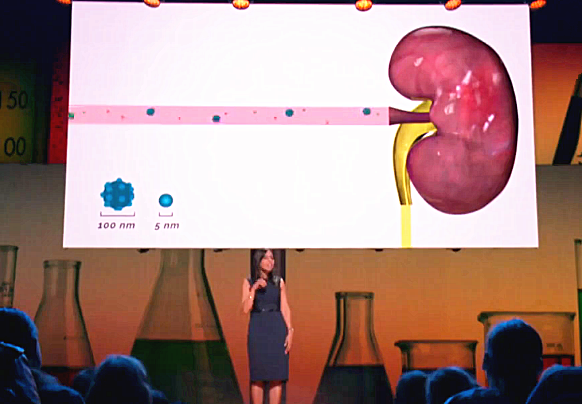In my lab, we recently made a cancer nanodetector
在我的實驗室,我們最近研制出了一種癌癥納米檢測器,
that is so small that it could travel into the body and look for tumors.
小到可以進入全身血液循環并尋找腫瘤。
We designed it to listen for tumor invasion:
我們設計它用于監聽腫瘤的侵襲:
the orchestra of chemical signals that tumors need to make to spread.
即腫瘤擴散所需要的化學信號。
For a tumor to break out of the tissue that it's born in,
一個腫瘤沖破包圍它的組織時,
it has to make chemicals called enzymes to chew through the scaffolding of tissues.
它需要產生一種叫做酶的化學物質,來分解組織的組成結構。
We designed these nanoparticles to be activated by these enzymes.
我們設計了這些會被酶激發的納米顆粒。
One enzyme can activate a thousand of these chemical reactions in an hour.
一個酶每小時可激發一千個這種化學反應。
Now in engineering, we call that one-to-a-thousand ratio a form of amplification,
用工程術語來描述的話,我們叫它1比1000的放大比例,
and it makes something ultrasensitive.
這就形成了一種超級靈敏的東西。
So we've made an ultrasensitive cancer detector.
所以我們已經做了一個超靈敏的癌癥檢測器。

OK, but how do I get this activated signal to the outside world, where I can act on it?
好的,但我如何把這激發信號傳遞到外界,好方便對其進行分析呢?
For this, we're going to use one more piece of nanoscale biology, and that has to do with the kidney.
針對這個問題,我們將采用另一項納米生物技術,與腎臟有關。
The kidney is a filter.
腎臟就是一個過濾裝置。
Its job is to filter out the blood and put waste into the urine.
它的工作是把血液中的廢物,過濾出來形成尿液。
It turns out that what the kidney filters is also dependent on size.
事實發現腎臟的過濾系統也是依據(過濾物的)大小。
So in this image, what you can see is that everything smaller than five nanometers
所以在這個圖中,你可以看到所有小于5納米的東西
is going from the blood, through the kidney, into the urine,
都會從血液穿過腎,變成尿液,
and everything else that's bigger is retained.
其他所有更大尺寸的會留下來。
OK, so if I make a 100-nanometer cancer detector,
好,那如果我制造一個100納米的癌癥檢測裝置,
I inject it in the bloodstream,
注射到血流中,
it can leak into the tumor where it's activated by tumor enzymes to release a small signal
它可以滲漏到腫瘤,并被腫瘤的酶激發,釋放出很小的信號,
that is small enough to be filtered out of the kidney and put into the urine,
小到可以被腎臟過濾出來并進入尿液中。
I have a signal in the outside world that I can detect.
我就有了一個可以在體外探測到的信號。
OK, but there's one more problem.
好,但是還有另一個問題。
This is a tiny little signal, so how do I detect it?
這是個小而微弱的信號,我怎么來檢測它?
Well, the signal is just a molecule.
實際上,信號就是一個分子。
They're molecules that we designed as engineers.
它們是我們作為工程師設計的分子。
They're completely synthetic, and we can design them
它們完全人工合成并且我們可以設計它們,
so they are compatible with our tool of choice.
所以它們和我們選用的工具相匹配。
If we want to use a really sensitive, fancy instrument called a mass spectrometer,
如果我們想使用一種非常靈敏先進的儀器叫做質譜儀,
then we make a molecule with a unique mass.
那我們可以讓這個分子有一個獨特的質量。
Or maybe we want make something that's more inexpensive and portable.
或者我們也許想要研制出一種更加便宜和便于攜帶的分析方式。
Then we make molecules that we can trap on paper, like a pregnancy test.
那我們就制造出可以滯留在紙上的分子,就像測孕試紙。
In fact, there's a whole world of paper tests
實際上試紙的應用已經非常廣泛,
that are becoming available in a field called paper diagnostics.
以至于專門形成了試紙診斷領域。



